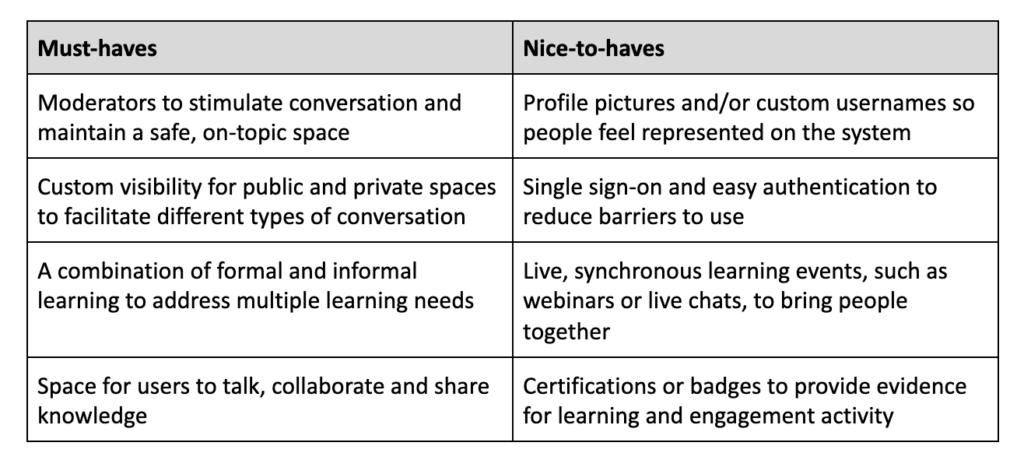With the global pandemic forcing many organizations to move their operations online, it has never been more important to keep your customers engaged from a distance. Overnight, organizations could no longer host customers in-person, whether that meant a quick catch-up over coffee, a meeting in the boardroom or a flashy customer event. Keeping customers engaged online can pose a challenge — but one way to succeed is with a learning community.
What is a learning community for customers?
Learning communities offer a way for organizations to upskill customers and keep them in the loop about current and upcoming developments. For instance, if you’re a software company, your learning community may comprise a series of e-learning courses to train end users how to use specific features, along with step-by-step guides, cheat sheets and more. A manufacturing company may also include PDF manuals and performance support for particularly complex operations.
What sets a learning community apart from a standard learning management system, however, is the ability to collaborate, communicate and connect with your peers. This may be in the form of forums, collaborative workspaces or status updates. This is best supported by a learning experience platform, which can then be coupled with your LMS to help surface and organize structured, formal learning into user-created playlists.
How to design a learning community
The most important goal of a learning community is to facilitate conversation, discussion and peer-to-peer learning. This means getting to know your customers and finding out why your community is needed. “Establish a common purpose,” says Rachel Griffith-Boyes, head of community services for the Totara Community. “There needs to be a reason your learning community exists.”
There is no set blueprint for designing a learning community, so get your customers involved from the start. You could send out a survey to find out what they would find useful and what they’d like to see in your community, or set up a focus group with a varied selection of customers to dig deeper into their learning needs.
Questions to ask include:
- What do your people need to know?
- How do they currently find what they need to know?
- What do they think of your existing learning program?
- What is missing from your existing learning program?
- Where do they go when they can’t find what they need?
- What systems do people already use and like?
- What other digital communities do they use in their lives outside work (e.g., neighborhood groups, hobby groups, parent groups)?
- What learning challenges do they currently face?
- Would they actually use a learning community? If not, why not?
Once you have a clear understanding of your customers’ needs, it’s time to take your findings to your stakeholders. Ensure you set out a timeline, a launch plan and the expected benefits of your new learning community, such as increased use of your products or services, upselling opportunities or fewer support requests.
At Totara, we recognized early on that our partners and customers required a place to go to share ideas and look for direction on getting the most out of their products. This open sharing of what works — and what doesn’t — directly informs our product development and ensures the whole community benefits from the experiences of others. The result is higher-than-average customer satisfaction and demonstrable return on investment for customers’ businesses. Happy, knowledgeable, well-connected customers tend to stay customers much longer.
How to build a learning community from scratch
Before you do anything else, ensure you have the right team in place. At a minimum, you’ll need someone to lead the project, someone to design and create the content, someone to build the platform, someone to design the look and feel and a community administrator to keep everything running smoothly.
Your learning community should bear a clear resemblance to the rest of your brand. Use the same logo, brand colors and imagery across your community to help establish trust among your customers, and implementing the same navigation or UX as your customer portal or company website will help get people up and running much faster than if you launch a brand-new, completely unfamiliar system.
Creating the right learning blend is a vital part of establishing a learning community. You can tailor your community to the needs of your customers based on your initial research, so you may decide to include structured e-learning, live webinars, on-demand videos, system simulations, PDF resources, podcasts and more. Additionally, you will need space for customers to discuss their challenges, share interesting resources and support each other.
While every learning community will look different, these are the must-haves and nice-to-haves to consider:

Launching your learning community
As we all know from launching a new LMS, simply building a new platform is only half the battle. In fact, it could be argued that building it is the easy part. Once your new learning community exists, you need to attract customers and get them using it.
Before you launch your community, make sure it is prepopulated with content. There should be enough for people to explore and get to know what your community is about, but not so much that it’s overwhelming. Enlist the help of “community ambassadors,” who may be some of your most engaged customers, to add some user-generated content, such as starting forum posts, creating “playlists” of useful content or uploading their own resources, to get the ball rolling.
You will also need to have moderators ready to go. They will be responsible for keeping the conversation going and keeping your community safe and respectful. They could be members of your organization, or as the community grows, volunteers from the community itself. Each moderator can be responsible for a separate forum or workspace to make sure everything stays on topic.
To get your community off the ground, you will need a comprehensive, multichannel marketing campaign. Email will be a useful tool here — set up several emails to announce the launch of your community to go out to your customer database, each focusing on different aspects of the community. You could also send out posters for your customers to put up in the workplace, post on social media and ask customers to promote your new community on their intranet to help get the message out.
One way to attract customers to a brand-new community is with a competition. You could offer a prize of a voucher, cash or branded merchandise to anyone who creates an account within the first month of launch to encourage customers to join. You could also take inspiration from organizations like Samsung, who continued to gamify the learning experience with points, leaderboards and badges to reward engagement over time.
How to maintain momentum
Once you’ve survived the first few weeks of your learning community, it’s crucial to maintain momentum.
“Before anything else, think about the triggers,” Griffith-Boyes says. “Initially, users will be interested because you’re offering them a new system to explore, but then what? Is your learning community automatically going to become part of their day-to-day activities? Almost certainly not — in which case, how do you interrupt them to remind them to come back? How do you make your community part of the way they operate? How do you reduce barriers to access? This is part of what the Totara Community team thinks about every day, and over time, we’ve seen our repeat visitors steadily increase as a result of our efforts.”
Organizations like Shimano keep independent mechanics coming back with an inviting extended enterprise learning platform. They award Open Badges to mechanics, inspiring them to become experts in their products while also motivating them to keep coming back to improve their knowledge for the reward of a badge. This is much more engaging than expecting external learners to trawl through product manuals and has resulted in more than 5,000 badges being awarded and more than 170,000 course completions to date.
If you’re looking to keep momentum going in your learning community, here are some things to consider:
- Maintain a regular content schedule by planning what you will post and when so customers know what to expect from you.
- Enable single sign-on or, even better, integrate your community with your other customer system for easy access and to reduce barriers to learning.
- Encourage the use of @mentioning users to draw others into the conversation. Your moderators can do this to lead by example.
- Give customers the freedom to upload their own resources and curate playlists of content they’ve found useful.
- Make use of system notifications to alert customers to new courses, resources and discussions.
- Promote content outside the community via your email newsletter or on social media to act as a nudge for existing customers and to encourage new sign-ups.
- Gamify the learning experience (e.g., award points to users for inviting new members and engaging in discussions).
- Create community ambassadors to recognize the contributions of your most active, engaged customers.
Additionally, ensure your learning community evolves with your organization. For instance, when the pandemic hit in 2020, many organizations adapted their digital presence to support their audiences. When many employees at Etex Building Performance were furloughed, the learning team created an additional area within the learning platform to facilitate communication between team members and managers. They added useful resources to enable employees to continue learning throughout the furlough period and helped alleviate stress and confusion by opening up additional communication channels and providing regular CEO updates.
The power of learning communities
Learning communities take effort and commitment — especially in the early days, weeks and months. At first, it’s your job to stimulate conversations, provide new content and listen to users to shape the evolution of the community. As the community grows and gathers momentum, your challenges will change, as you reevaluate your approach to moderation and the types of content that resonate with your users.
But if you’re willing to put in the initial effort, your learning community will quickly become a powerful, invaluable part of your learning strategy. Instead of creating all learning content yourself as workshops or e-learning courses, your users will start to learn from each other, share resources and make connections within your community — all with minimal input from you. With the right level of nurturing and support, your learning community will flourish over time, empowering your people to learn on their own terms and shine in their own areas of expertise.















